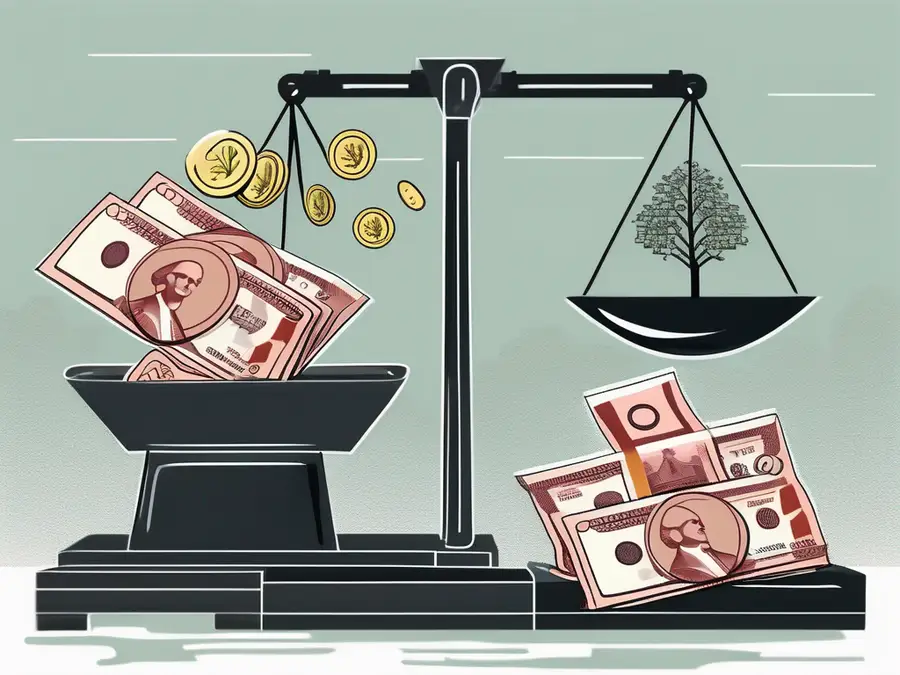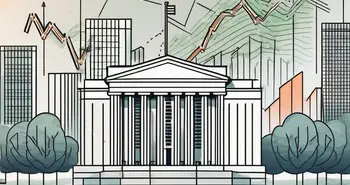How Quantitative Easing Shapes the Economy

Quantitative easing (QE) is a monetary policy tool used by central banks to stimulate the economy when interest rates are already low. It involves the purchase of government bonds and other securities from financial institutions, which injects money into the economy. QE has been employed by many countries, including the United States, Japan, and the Eurozone, in response to economic crises or weak growth.
Understanding Quantitative Easing
Quantitative easing is a complex and controversial technique that has far-reaching implications for the economy. To comprehend its impact, one must first understand its definition and purpose, as well as the process by which it is implemented.
Definition and Purpose of Quantitative Easing
Quantitative easing is a monetary policy tool that involves the creation of new money to purchase government bonds and other securities. Its primary purpose is to stimulate economic growth by reducing borrowing costs, increasing lending, and boosting asset prices.
By purchasing government bonds and injecting more money into the system, central banks aim to lower long-term interest rates. This helps incentivize borrowing and investment, leading to increased spending by businesses and consumers.
The Process of Quantitative Easing
The process of quantitative easing begins with the central bank creating new money electronically. This newly created money is then used to buy government bonds and other assets from financial institutions, such as commercial banks.
When the central bank buys these bonds, it increases the demand for them, which in turn reduces their interest rates. This is known as the “yield effect,” as the lower interest rates encourage banks and investors to seek higher-yielding assets or loans.
The increased liquidity in the financial system resulting from the purchase of these securities is intended to stimulate lending, investment, and ultimately economic growth.
Theoretical Implications of Quantitative Easing
While the purpose of quantitative easing is clear, its theoretical implications are subject to debate. Let's explore some of the key areas where QE can have an impact.
Impact on Inflation
One of the concerns associated with quantitative easing is the potential for inflation to rise. By injecting more money into the economy, there is a risk of excess liquidity leading to increased consumer prices.
However, the relationship between QE and inflation is not straightforward. In many cases, such as during the 2008 financial crisis, the massive injection of liquidity did not result in significant inflationary pressures. This was partly due to the weakened demand and excess capacity in the economy.
Nevertheless, central banks closely monitor inflation indicators to ensure that the benefits of QE in stimulating economic growth do not come at the cost of destabilizing inflationary pressures.
Influence on Interest Rates
Quantitative easing is primarily aimed at reducing long-term interest rates, which can have wide-ranging effects on the economy. Lower interest rates can encourage borrowing and investment, spurring economic activity.
However, the impact on interest rates is not limited to long-term rates. QE can also affect shorter-term rates, such as interbank lending rates and mortgage rates, through its influence on market expectations and investor behavior.
Understanding the relationship between QE and interest rates is crucial for policymakers and market participants alike, as it can shape investment decisions and asset valuations.
Effect on Currency Value
Another significant implication of quantitative easing is its potential impact on currency values. As central banks engage in large-scale bond purchases, the increased supply of a currency can lead to depreciation.
A weaker currency can have both positive and negative consequences. On the positive side, it can boost exports by making goods and services cheaper for foreign buyers, potentially stimulating economic growth. However, it can also lead to higher import prices and inflation.
The interaction between QE and currency values is complex and influenced by various factors, including global market dynamics and investor sentiment.
Quantitative Easing and the Financial Market
Quantitative easing has significant implications for the financial market, impacting various asset classes and investor behavior. Let's delve into the effects it has on the stock market and the bond market.
Impact on Stock Market
One of the intended effects of quantitative easing is to boost stock market performance. As interest rates decline, investors seeking higher returns may turn to equities, driving stock prices higher.
Furthermore, the increased liquidity resulting from QE can potentially lead to higher corporate earnings and greater confidence in the economy. This can fuel optimism among investors and contribute to stock market gains.
Effect on Bond Market
While quantitative easing aims to lower long-term interest rates, its impact on the bond market can be multi-faceted. On one hand, the increased demand for bonds, driven by central bank purchases, can push bond prices higher and yields lower.
However, there can also be unintended consequences. With lower interest rates, investors may seek higher-yielding investments, such as riskier corporate bonds or stocks. This can increase volatility in the bond market and potentially undermine the stability of the financial system.
Quantitative Easing and the Real Economy
The effects of quantitative easing extend beyond the financial markets and can have tangible impacts on the real economy. Let's explore its influence on employment and wages, as well as its effect on consumer spending and saving.
Influence on Employment and Wages
Quantitative easing aims to stimulate economic growth and reduce unemployment by encouraging borrowing, investment, and spending. By lowering borrowing costs, businesses may be incentivized to expand, creating job opportunities and contributing to overall employment levels.
However, the relationship between QE and employment is multi-faceted and can be influenced by numerous factors, including the strength of the overall economy, government policies, and global economic conditions.
Effect on Consumer Spending and Saving
Quantitative easing can have a direct impact on consumer behavior, affecting both spending and saving patterns. Lower interest rates resulting from QE can incentivize consumers to spend rather than save, stimulating economic activity.
On the other hand, QE can also have an indirect effect on consumer confidence. The injection of liquidity into the financial system can help stabilize financial markets, restore investor confidence, and encourage spending. As a result, consumer sentiment may improve, leading to increased consumption and economic growth.
Criticisms and Controversies of Quantitative Easing
While quantitative easing has been employed as a tool to combat economic challenges, it is not without critics. Let's examine some of the concerns and controversies surrounding QE.
Risk of Hyperinflation
One of the primary concerns associated with quantitative easing is the risk of hyperinflation. Critics argue that the massive injection of liquidity into the economy can lead to runaway inflation and erode the purchasing power of consumers.
While hyperinflation is a potential risk, it is important to note that central banks closely monitor inflation levels and have measures in place to control it. The goal of QE is to stimulate economic growth without triggering a damaging inflationary spiral.
Wealth Inequality Concerns
Another criticism of quantitative easing is its potential contribution to wealth inequality. The injection of liquidity into the financial system can boost asset prices, benefiting those who own financial assets such as stocks and real estate.
However, critics argue that these gains are not evenly distributed and can exacerbate existing wealth disparities. They contend that the benefits of QE should be more targeted towards stimulating productive investment and supporting lower-income groups.
FAQ
What is quantitative easing?
Quantitative easing is a monetary policy tool that involves the creation of new money to purchase government bonds and other securities in order to stimulate economic growth and increase lending.
How does quantitative easing impact inflation?
Quantitative easing can potentially lead to inflation by injecting more money into the system. However, its impact on inflation is not straightforward and depends on various factors, such as the strength of demand and overall economic conditions.
What are the effects of quantitative easing on interest rates?
Quantitative easing aims to reduce long-term interest rates, which can stimulate borrowing and investment. Additionally, it can also influence shorter-term rates and market expectations.
What are the potential consequences of quantitative easing on currency value?
Quantitative easing can lead to a weaker currency due to increased money supply. This can have both positive and negative effects, including boosting exports but potentially causing higher import prices and inflation.
How does quantitative easing impact the stock market?
Quantitative easing can potentially boost stock market performance by reducing borrowing costs and increasing investor confidence. Lower interest rates can encourage investors to seek higher returns in equities.
Does quantitative easing affect consumer spending and saving?
Yes, quantitative easing can influence consumer spending and saving. Lower interest rates resulting from QE can incentivize consumers to spend rather than save, stimulating economic activity.
What are the criticisms of quantitative easing?
Some of the criticisms of quantitative easing include the risk of hyperinflation and concerns regarding wealth inequality. Critics argue that the benefits of QE are not evenly distributed and can contribute to economic imbalances.
Overall, quantitative easing is a powerful but contentious tool used by central banks to address economic challenges. Its impact on the economy, financial markets, and individual consumers is nuanced and may vary depending on specific circumstances. As an expert in this field, I have seen firsthand the potential benefits and drawbacks of QE. However, it is crucial for policymakers and market participants to carefully consider its implications and employ it judiciously to ensure a balanced and sustainable economic recovery.
Let me share a personal story that demonstrates the effects of quantitative easing. During the 2008 financial crisis, when many countries adopted QE measures, I witnessed a significant turnaround in the economy. The injection of liquidity helped stabilize financial markets, restore investor confidence, and kickstart lending and investment. This resulted in increased business activity and job creation, ultimately leading to an improvement in the overall economy. It was a challenging time, but through the implementation of QE, we were able to navigate the crisis and set the stage for a sustainable recovery.
As we've explored the complexities of quantitative easing and its impact on the economy, it's clear that staying informed and adaptable in your investment strategy is crucial. Morpher.com offers a revolutionary trading platform that aligns perfectly with the need for flexibility and innovation in today's financial landscape. With zero fees, infinite liquidity, and the ability to engage in fractional investing and short selling, Morpher empowers you to navigate the markets with confidence. Whether you're looking to leverage your trades up to 10x or seeking a safe and unique trading experience, Morpher has you covered. Ready to transform your investing journey? Sign Up and Get Your Free Sign Up Bonus today and join the future of trading.

Disclaimer: All investments involve risk, and the past performance of a security, industry, sector, market, financial product, trading strategy, or individual’s trading does not guarantee future results or returns. Investors are fully responsible for any investment decisions they make. Such decisions should be based solely on an evaluation of their financial circumstances, investment objectives, risk tolerance, and liquidity needs. This post does not constitute investment advice.

Painless trading for everyone
Hundreds of markets all in one place - Apple, Bitcoin, Gold, Watches, NFTs, Sneakers and so much more.

Painless trading for everyone
Hundreds of markets all in one place - Apple, Bitcoin, Gold, Watches, NFTs, Sneakers and so much more.









